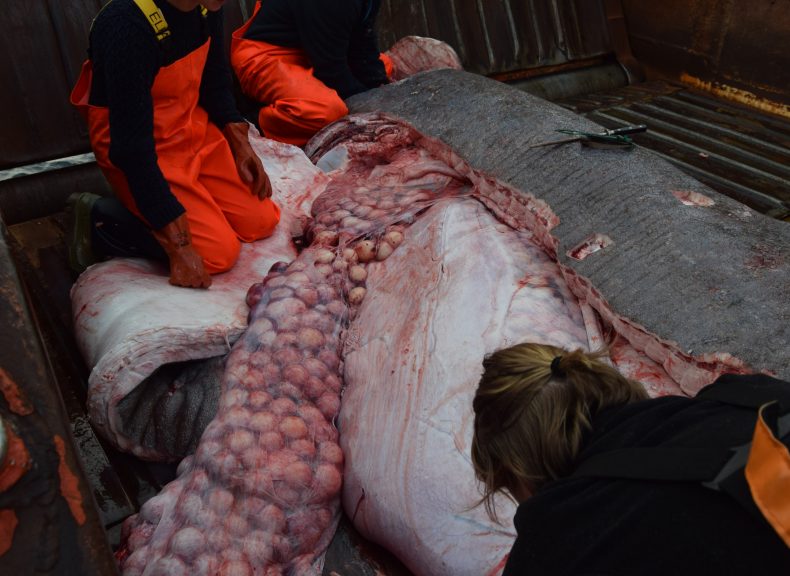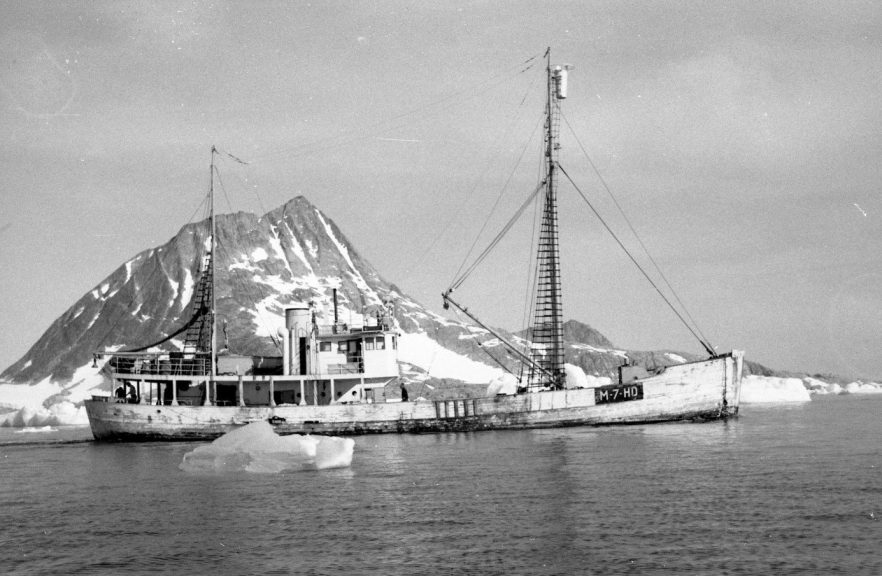The Greenland shark – old and fertile Published 09.11.2020

Greenland shark’s way of reproduction may be key to understanding why it has not yet been exterminated
By: Biologist Julius Nielsen, Greenland Institute of Natural Resources.
Research news from Greenland Institute of Natural Resources:
Data collected over 50 years sheds light on an unknown part of the Greenland shark’s life
In collaboration with scientists from Copenhagen University and UiT The Arctic University of Norway, a research team from Greenland Institute of Natural Resources have recently published the most comprehensive scientific article to date on the Greenland shark’s reproductive biology – that is, a study of the biology associated with the shark’s reproduction. On the basis of observations of no less than 312 Greenland sharks, the scientists have described seven different maturation stages for females and three for males. In addition, the team have studied the size of males and females by the time the sharks reach sexual maturity and have found a possible explanation for why the Greenland shark, despite its advanced age at sexual maturity and decades of direct and indirect catch, is still numerous in Greenlandic waters.
A treasure of data from a Norwegian desk drawer
Until a few years ago, knowledge on the Greenland shark’s reproductive biology was scarce. Therefore, during his masters and PhD studies, scientist Julius Nielsen from Greenland Institute of Natural Resources had collected all sorts of data on the Greenland shark’s biology. While collecting, surprising data appeared from an unexpected source: after a radio interview on the Greenland shark’s age, Julius’ PhD supervisor, Professor Jørgen Schou Christiansen from UiT The Arctic University of Norway, was contacted by an elderly lady, Wenche Berland, who was in possession of a large amount of unpublished data from her now deceased husband, the Norwegian marine biologist Bjørn Berland. He had sailed with a Norwegian sealing and sharking vessel in East Greenland in the years 1959 and 1960 and thereby collected extensive data on the Greenland shark. The quality of the material was so good that it could be used directly in Julius’ ongoing studies of the Greenland shark’s reproductive biology.
An old fish with many eggs
The Greenland shark became world-famous in 2016, when the aforementioned Danish-Norwegian research team made the frontpage of the renowned scientific journal Science with sensational new knowledge about the age of the Greenland shark. The team’s study showed that the largest Greenland sharks may become several hundred years old. However, this is, after all, “old news”, so we won’t deal with it here. The latest studies of the research team confirm the previous assumptions that the females only reach sexual maturity when they are more than 100 years old and measure at least 3.9 metres from snout to tip of the tail fin. The males are generally smaller and can reach sexual maturity already at 2.7 metres. The latest studies also show that sexually mature females can produce large amounts of eggs, documenting between 400 and 649 eggs measuring between 6 and 8 cm in diameter. In this regard, the obvious question is, how many of these eggs may be fertilized and develop into pups per pregnancy.
An unusual shark – like all the others
Scientists have yet to study the number of pups in pregnant females, which has only been observed once, in 1957, when a Greenland shark from the Faroe Islands was reported to have 10 fully developed pups in the womb. Since this observation, science has assumed that the Greenland shark has relatively few pups per pregnancy. However, it is possible that these 10 pups were the last of a much larger batch during the pregnancy. For closely related sharks of the same order (Spiny dogfish, Squaliformes), reproductive biology has been studied thoroughly, and Spiny dogfish have an important common feature across species, specifically, the number of pups that develop per pregnancy in the womb roughly corresponds to the number of mature eggs in the ovaries. For more distantly related shark species, such as the Porbeagle and the Sand tiger shark (Shortfin mako sharks, Lamniformes), we know that unborn pups prey on unfertilized eggs and even each other while they are fetuses in the womb. Nevertheless, there is no reason to expect that Greenland shark fetuses eat eggs, which means that, even if only half of the eggs develop into pups, a Greenland shark may have between 200 and 324 pups per pregnancy.
As a result, the Greenland shark is probably among the sharks that have most pups per pregnancy world-wide. Precisely this may be a large part of the explanation why this species is still numerous in Greenland despite a targeted yearly catch of approx. 44,000 sharks in Greenlandic waters in the first half of the last century along with decades of by-catch in trawling.
More knowledge necessary
Not only does this story provide new knowledge about the Greenland shark’s biology, it is also an example of how important it is to talk about science. If Jørgen Schou Christiansen hadn’t done the interview in Norwegian radio, the scientists would never have had access to Berland´s material. And with this article, we may reach fishers here in Greenland, who once saw a pregnant female, helping us to understand the last pieces of the shark’s reproductive cycle. Today, we are still not certain, how many pups the Greenland shark is able to have, where they are born, or how long a pregnancy lasts – important questions we may be able to answer in the future.
Link: https://journals.plos.org/plosone/article/comments?id=10.1371/journal.pone.0238986

Photo 1: A 266 cm long Greenland shark from North-East Greenland caught under the auspices of the TUNU-programme (UiT). Photo: Arve Lynghammar.

Photo 2: Ice-sea vessel Brandal was one of the vessels that Bjørn Berland sailed with in Greenland to collect data on Greenland sharks. According to Ishavsmuseet.no, this boat was also part of the expeditions to find Roald Amundsen in 1928, before it was enlisted in service to Germany in the years 1940-45. Photo: Ishavsmuseet’s archives, photographer Bjørn Berland.

Photo 3: Unfertilized eggs from Greenland shark. Photo: Julius Nielsen

